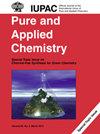Comprehensive evaluation of the impact of ionic liquid incorporation on the optical properties, Urbach energy, thin film morphology, and surface roughness of poly(vinyl chloride) based on ionic materials
IF 2
4区 化学
Q3 CHEMISTRY, MULTIDISCIPLINARY
引用次数: 0
Abstract
A newly synthesis composite thin films of poly(vinyl chloride) has been refinement with ionic liquid, where PVC dissolved in THF with various concentrations of IL by casting method to form the composite thin films, without any reaction and IL dangles within PVC matrix. The thin films were examined by the diffusive reflectance device under the wavelength range (238–1300 nm). The XRD, EDX, and AFM techniques were utilized to discover the structure of the PVC matrix after additive IL. The XRD analysis illustrated the amorphous structure of the films, while the EDS analysis illustrated the main composition of pure PVC and composite PVC/IL. The optical properties and optical parameters were studied. The reflectance, extinction factor, transmittance, and imaginary dielectric constant declined, the absorption value was between (80–89 %), and the refractive index, real dielectric constant, and optical conductivity were increased. The indirect energy gap declined from 4.2 eV to 2.2 eV and the direct energy gap declined from 3.7 eV to 2.6 eV. The Urbach energy was increased from 2.09 eV to 15.45 eV revealing an increase in the disorders of electrons. The全面评估离子液体的加入对基于离子材料的聚氯乙烯的光学特性、厄巴赫能、薄膜形态和表面粗糙度的影响
一种新的聚氯乙烯(Vinyl chloride)与离子液体复合薄膜的合成方法是将聚氯乙烯溶解在 THF 中,加入不同浓度的离子液体,通过浇铸法形成复合薄膜,在聚氯乙烯基体中离子液体悬浮,不发生任何反应。薄膜在波长(238-1300 nm)范围内通过漫反射装置进行检测。利用 XRD、EDX 和 AFM 技术发现了添加 IL 后 PVC 基体的结构。XRD 分析表明了薄膜的无定形结构,而 EDS 分析表明了纯 PVC 和 PVC/IL 复合材料的主要成分。对光学特性和光学参数进行了研究。反射率、消光系数、透射率和虚介电常数下降,吸收值介于(80-89 %)之间,折射率、实介电常数和光导率上升。间接能隙从 4.2 eV 下降到 2.2 eV,直接能隙从 3.7 eV 下降到 2.6 eV。厄巴赫能从 2.09 eV 增加到 15.45 eV,表明电子失调增加。E d 从 23.42 eV 增加到 70.68 eV,E o 从 7.00 eV 增加到 10.88 eV。原子力显微镜分析表明,在 PVC 基质中添加 IL 后,薄膜的粗糙度从 1.08 nm 增加到 4.45 nm,颗粒的均方根从 1.57 nm 增加到 5.56 nm。这种 PVC 复合薄膜可用于太阳能电池和钠离子电池。
本文章由计算机程序翻译,如有差异,请以英文原文为准。
求助全文
约1分钟内获得全文
求助全文
来源期刊

Pure and Applied Chemistry
化学-化学综合
CiteScore
4.00
自引率
0.00%
发文量
60
审稿时长
3-8 weeks
期刊介绍:
Pure and Applied Chemistry is the official monthly Journal of IUPAC, with responsibility for publishing works arising from those international scientific events and projects that are sponsored and undertaken by the Union. The policy is to publish highly topical and credible works at the forefront of all aspects of pure and applied chemistry, and the attendant goal is to promote widespread acceptance of the Journal as an authoritative and indispensable holding in academic and institutional libraries.
 求助内容:
求助内容: 应助结果提醒方式:
应助结果提醒方式:


